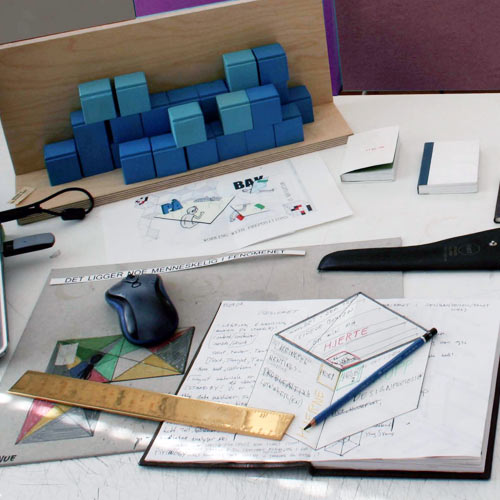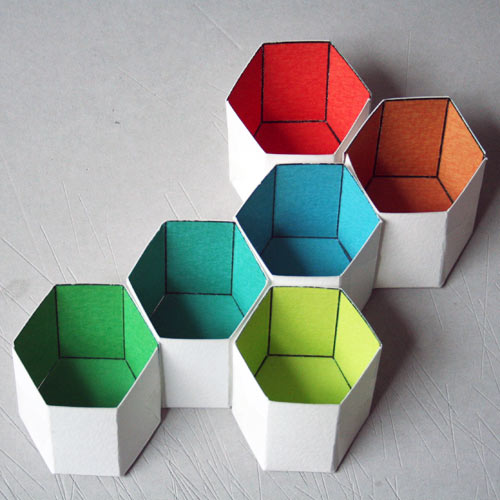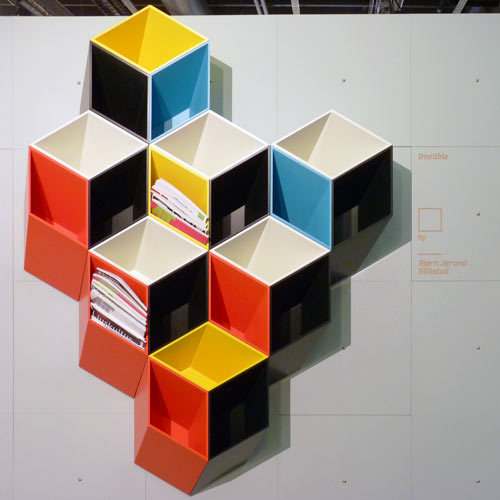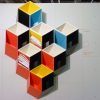
In January 2010 Bjørn Jørund Blikstad’s prototype for a modular storage system graced the cover of Wallpaper* magazine and then the pages of Design Milk. Two agonizing years later at February 2012’s Stockholm Furniture Fair, he finally launched Imeüble. I spoke to him about the long road from the inspiration to production.
How did the initial idea for Imeüble come about?
“The cube you can see with your mind eye, does it have storage capacity?” was a sort of headline for my research into storage and retrieval. I tried to establish a link between content and container, as an idea for storage design in general. Because what we seek to store or retrieve in our archives are vivid imagery from books, letters, photo albums, objects; it’s ‘the memories of’ that are important, not the symbols or objects themselves. So I researched for a system where the memories and the stored place of this memory making item came together. “Filed away, forever separate” [David H. Freedman, 2006]; quite the opposite from our minds where everything’s a mush.

What does the name mean?
The word used for furniture in Norwegian is “møbel” from the latin word mobilis meaning mobil(e) or moveable. The French use the same word written “meuble.” The IMEÜBLE is a modular storage device, mounted on the wall and thus becomes immobile… a contradiction. I’ve attached the umlaut to add a more cross-European twang…

Describe the process of capturing that idea – did you draw it, write it down, get straight into model making…?
The idea for the Imeüble storage device came about right at the end of my MA-program. I had made many different models of different storage designs over the content/container theme and was determined to make one of these in full size for the examination. They were all quite elaborate designs with a lot of mechanical parts and difficult manufacturing. There came a time when I finally got to clean my workspace. When I started labeling my cardboard box of geometrical paper foldings with a white hexagon, it dawned on me. I’d been very interested in geometry for the same reason I was interested in texts; geometrical figures (especially the platonic solids) can all be constructed on paper with a compass, and they suddenly seam to pop up in three dimensions in the same way imagery appears when you read something. So when I attached this flat representation of a cube onto my cardboard box of platonic solids in various degrees of dimensionality I suddenly understood how I could make a link between the content and the container.

Then I worked with the colors. I did this on paper with different colored cutouts which I moved about. I wanted to use the minimum amount of flat cubes for every aspect of the illusion to be at its best. With six arranged in an arrow type of fashion pointing down you get three extra “cubes” in between. The seventh asymmetrically placed on top ads a sculptural quality to the otherwise strict and geometrical pattern which seemed too mathematical.

Once you’d described the idea, how did you move towards a prototype? What modelling techniques did you use? What materials did you build models from? What was tried and discarded?
After figuring out how it could be constructed and understanding the connection between the different sides, which took over two weeks (trying to make a schematic drawing of an optical illusion based shelf is actually quite hard on the eyes!) I made the shelf in MDF less than a week. To get there I used a lot of paper folding and CAD.

At what point in the prototyping were you satisfied that you had an idea that would work?
The idea had many different manufacturing approaches leading to different visual and functional effects. (I think similarly about how things can be made because I have to make it myself) Some were more static and some were less “cubed” and more “honeycombed”.
I was happy when I’d figured out that the best way to make it, mount it and use it would give the best opportunity for the modular aspects of the idea. I always work towards a high level of consistency of all aspects of a project. There is always some compromise, but not this time…
I finished painting it the day before the examination. I had to sleep on shifts because of the drying time of the paint.

How did the Wallpaper* cover come about? How did that feel? Did it add extra pressure to get a finished product?
From the time I first exhibited the shelf, I almost haven’t had any time with it. From the first exhibition it got to a bigger one, then to London for the Wallpaper* photography. Then back to the bigger exhibition which lasted a year. When I finally got to mount it on my living room wall I had to send two of the seven pieces to Paris. Now I only have three, missing the touring four.

The Wallpaper* cover story is also quite elaborate. I think there were three roads to Wallpaper*. Henrietta Thompson from Wallpaper* visited the first exhibition where she saw it and must have noticed it then. I talked to her about it and she asked me directly if there was anything behind the design; that it wasn’t just a lucky shot. Meanwhile someone else from Wallpaper* had asked my professor if there was any noteworthy graduation student design this year. He mentioned me and I guess he would also like some of the credit. Maybe it wasn’t one or the other, maybe it was both. I still think about this cover in an unbelievable way. [It] still feels dreamy.
It was never designed as a prototype for a product for sale. I was made to summarize my MA-thesis in a good way. So when this cover came about I got quite stressed in getting it to a finished product. Thinking that people would like a copy of it. I think I doubled my age during 2010/11. If I ever started losing my hair it was then.

Describe the process you’ve been through since then to get to the final product.
I have talked to many manufacturers to no avail. Some didn’t understand it, some made it too expensive, and I even had it in China for six months. But they couldn’t get it either. This was a very frustrating time for me. When I signed with by/ everything just slipped into place. The factory understood everything and worked with it to a degree where they felt a little ownership. That’s always a good thing.

How is the final product manufactured?
It’s made with a fantastic CNC routing setup where the MDF plates are painted on one side, then routed and cut, glued together then put in a specially designed spray coating jig.
How did you feel when you saw the first finished product?
Relief. Yes. Thank God. It was a very good feeling to allow my hopes up. After so many “perhaps this time? No”s – it felt good to open up for a euphoric sensation again.

What are you most proud of about the whole process?
Apart from being proud of the Wallpaper* cover, I am very proud of my MA-thesis.
What advice would you give to anyone about to embark on a similar process?
The managing side of this game is not something I was built for. Neither had I any experience of it, nor did I study it. Everything went so much easier when I teamed up with someone who knew. The feeling of being in good hands and that things are taken care of, things that are too difficult for you, is something I really would advise others in a similar process to think about. It’s not only to be able to focus on what you do best, but to avoid stress related illness. I think this is how some people get burned out. Everyone is different, so my advice is to team up with someone who knows the stuff you don’t.








